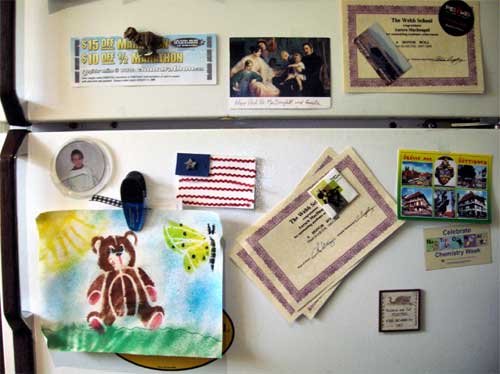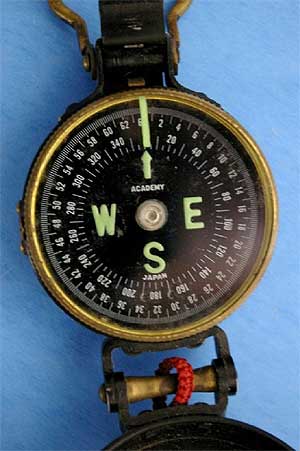 by Preston MacDougall May 19, 2008
Copper pipes don't have it, but the copper atoms that are an essential part of our diet do. They can even turn it off and on during the enzyme-moderated chemical reactions that our bodies need copper for. Magnetism, which is what I have been referring to, is a curious phenomenon. And that applies to both the animate and the inanimate varieties. In the atomic world, there are two kinds of magnetism - paramagnetism and diamagnetism - that result from the combined and complex interactions of atoms and their constituents. While the Earth and compass needles have North and South poles, atoms and molecules are said to have up and down spin, which refers to the fact that most magnetism is due to the spinning of electrons in one of only two possible directions.  Credit: P. J. MacDougall
Diamagnetism is a weakly repulsive response by an atom or molecule to any magnetic field. It increases with the strength and proximity of the magnet, but is independent of which pole is nearby. Most atoms exhibit this kind of magnetism, and this is the only kind of magnetism exhibited by most organic compounds. You can't make a child's artwork stick to a fridge door with diamagnetism, so most people were unaware of this form of magnetism until magnets were strong enough to make frogs fly on YouTube. Creativity in art class can be enhanced by a teacher with a magnetic personality, but refrigerator magnets rely strictly on paramagnetism. This is the form of magnetism that results in the attraction of paramagnetic atoms or molecules towards any magnetic field. In this case, the orientation does matter, and each pole of the atom or molecule will preferentially align with the opposite pole of the magnet. Memories from your child's Kindergarten class can be saved with the help of paramagnetism on the fridge door, but paramagnetism can also save memories of business conventions in Las Vegas as password-protected jpeg files in your computer's hard drive. That's because the materials that are used to store bits of information in hard drives contain billions of isolated magnetic domains that have a high density of strongly paramagnetic atoms within each domain. Originally, the same iron-containing compounds that were used in cassette tapes were also used in both hard and floppy drives in computers. But other elements, such as cobalt, in exotic chemical combinations, are currently being used in ever smaller devices that hold more and more memories. Advances in materials science, such as the Giant Magnetoresistive effect, will eventually reach the size limit of top-down electronic engineering. Further advances will then require a bottom-up approach that is not fundamentally different from how chemists design and synthesize drugs or plastics from atomic building blocks. The new challenge will be to build strong paramagnetism into the desired molecular properties, in addition to the structural and chemical requirements that go along with any purpose-driven material design. But computers don't just store information, they also process it. Similar design challenges will test the chemists tasked with taking integrated circuitry and its components from the micro to the nano world. Interestingly, one approach to a future of molecular electronics involves so-called spin gates instead of semiconductor transistors. So it is conceivable that magnetism will be central to both data storage and processing. When Sputnik flew overhead, and the US entered the "space race", we had only one competitor - the Soviet Union. In the current race for technological prowess, which will largely determine economic fortunes, we have a global village of competitors. High-quality education in science and mathematics - from Kindergarten through post-graduate - will be just as crucial to solving technological challenges at the nano-scale as it was at the astronomical one. And just as in art class, a magnetic science teacher will attract properly-oriented students and encourage them to take an active part in creative science projects. This might even result in a Science Fair prize that parents can stick on the fridge. Part 2 In magnetism as well as geography, you can't have a North without a South. And any good yarn has both a beginning and an end - but not necessarily in that time orientation. Part 1's commentary about magnetism was actually the end of the story. This is the beginning. It was time for the 2008 CMT Music Awards on the campus of Belmont University in Nashville, and just as for the last two years, that meant that Tennessee's brightest stars were anxiously rehearsing for their chance to take home one of two coveted awards - at the annual meeting of the Tennessee Junior Academy of Science. For the third year running, the high school science competition was held on Belmont's campus the same week as the CMT Music Awards. From about one-hundred entries, Jack Rhoton, the longtime Director of the Junior Academy, had lined-up two dozen finalists from all three grand divisions of the state; East, West, and Middle. They each would make a short PowerPoint presentation describing their project, with our without props, but only two would take home a generous cash award.
There was also the little matter of questions from the judges, which is where I come into the story. This year, there were three judges on campus, but like on American Idol recently, only two of the judges were really there. It's a long story, but not part of this one, even though it involves orientation. This story picks up the magnetism yarn with the morning presentation by Mr. Chris King from Creek Wood High School in Charlotte, which is a small town in a rural part of Middle Tennessee. Chris's project was inspired by a novelty item that he purchased from a toy store. One part of the toy seemed to float above the rest, but was not connected in any way. In fact, it felt as though it was sitting on an invisible cushion. Chris either knew about magnetic fields from science class, or had seen "The Brave Little Toaster", because he figured out that the purpose of the battery hidden in the base of the toy was to generate a magnetic field that would repel the floating permanent magnet. The familiar force of gravity also took its part in the balancing act of this forceful duet. What made Chris's science project so impressive was not that it was a homemade novelty, but that he suspended things in mid-air below his homemade electromagnet. In other words, gravity was working to spoil his levity, not to maintain it. He did some research and discovered the Hall Effect, which is experienced whenever electrically charged particles, such as electrons in an electrical circuit, move across magnetic field lines. It is often used as a very sensitive and precise motion detector that can operate in the dark, and does not require contact between the sensor and the sensee. Using store-bought Hall sensors and electromagnets, and a self-designed circuit-board that ran a computer program that he wrote to provide a feedback loop between the sensors and the electromagnets, Chris could suspend objects above or below his new toy. Chris's presentation was titled "Electromagnetic Levitation: A Digital Control System", and it was only the third in the line-up. After his answers to challenging questions convinced us that he had done all of the work himself, the look exchanged between judges was unmistakable: "I wonder who will win the other prize?" That went to Charlie Xie, who had performed experiments measuring paralysis of worms with different brain chemistry-related genes "knocked-out". He obtained these genetically modified worms from a biotechnology supply company, but his mastery of the genetics, as well as his understanding of the relation between his research and diseases such as Parkinson's Disease, was clearly homemade. Well, it wasn't completely homemade, some of it came from the science classroom. I know that because I was watching Charlie's face while Jack Rhoton was reading from the nomination materials for the Science Teacher of the Year Award for Middle Tennessee. It went to Chand Desai from the Martin Luther King Academic Magnet School in Nashville, which is where Charlie Xie and another finalist were from. Dr. Desai was described as "the smartest person I've ever met" by one of his students (I have an idea which), and this may not be an exaggeration. After getting a B.S. in Biochemistry from Berkeley, and a Ph.D. in Biology from MIT, and after a while running on the tenure-track at a well-known research university where he spent much more time in a laboratory than a classroom, Chand was attracted to the academic magnet school in Nashville that specializes in health sciences and engineering. The metaphor of classroom magnetism filled my thoughts while I was listening to his curriculum vitae, which involved an intellectually charged scientist circulating between the classroom and the laboratory. And the testimonials of his students made it clear that he was the force who had attracted them to doing their own scientific research. And that's the beginning of
the story.
On the Web:
E-mail your letters & opinions to editor@sitnews.us SitNews ©2008 Stories In The News Ketchikan, Alaska |
||
